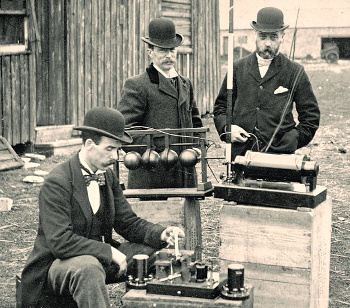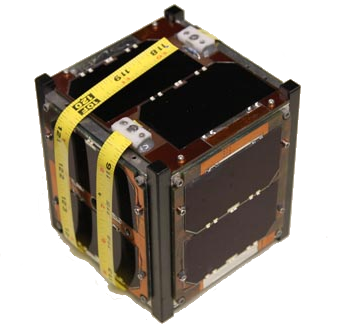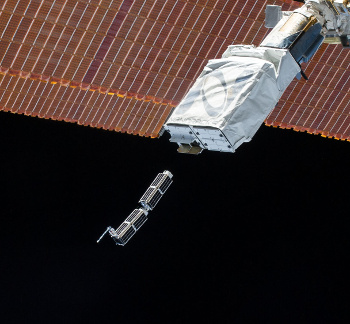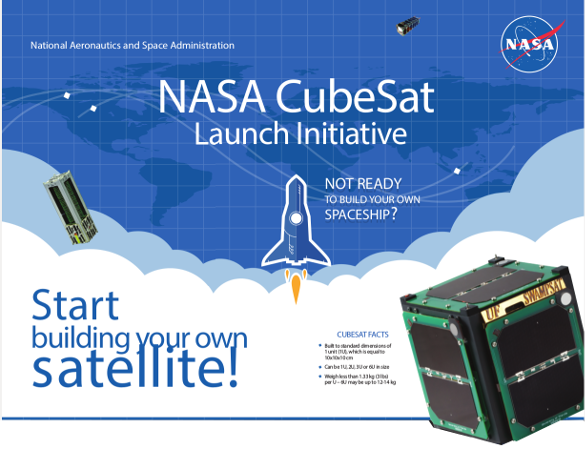CubeSats
February 2, 2015
Technology has a way of devolving from the complex and unique to the simple and ordinary.
Pressmen from
Gutenburg's time onwards labored mightily to produce
printed books, while
authors today
self-publish their works with a press on a
keyboard.
Marconi struggled to attain
transoceanic telecommunications at the turn of the
twentieth century, and now
amateur radio operators do the same routinely from the comfort of their
homes.

Marconi wireless test at Flat Holm island, 1897.
This was the first radio transmission over open sea, over a distance of three miles. Marconi achieved transatlantic communication on December 17, 1902.
(Via Wikimedia Commons.)
So it is also for
spaceflight. The
Soviet Union launched the
Sputnik 1 artificial satellite on October 4, 1957, and the
United States followed soon thereafter with its
Explorer 1 on February 1, 1958. In those days, putting even a small satellite into orbit
was difficult.[1] Now,
modern launch vehicles make boosting satellites into
orbit routine, and millions of people get their
entertainment from
direct-broadcast satellites.
Now, nearly anyone can launch a small, one
kilogram,
cubic satellite, 10x10x10
cm in size, into
Earth orbit for about $100,000. These
CubeSats have been conventionally launched, and deployed also from the
International Space Station. A lengthy
list of launched CubeSats can be found on
Wikipedia. The
journal,
Science, designated the CubeSat as one of the significant scientific achievements of 2014.[2]
The CubeSat concept is just a little more than a
decade old, but the
history of
amateur satellites started much earlier. A group of amateur radio operators, some of whom had experience in satellite technology, convinced
NASA to replace a small
balancing weight in a satellite payload with a small satellite of their own design and construction. NASA requirements were that this satellite, known as
OSCAR 1 needed to be a particular shape and weight, and it could contain no
propulsion system.
OSCAR 1, was launched into Earth orbit just a little more than four years after the launch of Sputnik I. OSCAR 1 contained a 140
milliwatt, 144.983
MHz,
battery-powered transmitter broadcasting "HI" in
Morse code (•••• ••) for about three
weeks. It was the first private spacecraft. Subsequent OSCAR satellites were designed to act as
radio repeaters, the
amateur radio equivalent of the
Telstar satellite.
In a move to extend the capability of inexpensive satellites to do other things,
California Polytechnic State University at San Luis Obispo and
Stanford University (Stanford, California) developed the CubeSat
specification in 1999. CubeSat documentation is available online at
cubesat.org, and there are also
workshops to train developers in CubeSat fundamentals.[3]

University of Michigan "Michigan Multipurpose Minisat" (M-Cubed) CubeSat.
This CubeSat, designed for Earth imaging, has been in orbit for more than three years.
(Via M-Cubed Web Site.)
More than seventy-five CubeSats were placed into orbit in 2014. Their low cost and rapidity of deployment have allowed developers to field
risky technologies and use the best available
components, such as better
solar cells and faster
computer chips, immediately.[2] They are being used in
multispectral imaging to monitor
urbanization and
deforestation.[2]
CubeSats don't even need to be cubes, although their length can be expanded in one
direction, only, up to six unit lengths (10 cm x 10 cm x 60 cm). NASA has developed a CubeSat launch system called a "
Poly-Picosatellite Orbital Deployer" (P-POD).[4] NASA, which has always courted
public interest as a way to keep the the
funds flowing, has a
CubeSat Launch Initiative as part of its
Education Strategic Coordination Framework. This initiative encourages
scientific and
educational uses of CubeSats.[4]

Launch of CubeSats from the International Space Station on February 11, 2014.
These were launched by the Small Satellite Orbital Deployer attached to the Kibo laboratory robotic arm.
(NASA image.)
NASA has a goal in its CubeSat Launch Initiative of having fifty CubeSats launched by teams in all fifty
US states within five years. At this point, there are still twenty-one states missing from the roster of CubeSats either launched or in development, including
Tikalon's home state of
New Jersey. Teams from New Jersey's neighboring states,
New York and
Pennsylvania, have CubeSat teams. NASA, however, is not providing funding for the development of these satellites. [5]

Portion of a NASA CubeSat poster. Click for larger image.
(Via NASA.)[6]
References:
- Vanguard TV3 Rocket Launch Explosion, YouTube Video.
- Eric Hand, "Comet Breakthrough of the Year + People's choice," Science, vol. 346, no. 6216 (December 19, 2014), pp. 1442-1443, DOI: 10.1126/science.346.6216.1442.
- CubeSat Web Site.
- NASA CubeSat Launch initiative (CSLI).
- CubeSat Launch Initiative: 50 CubeSats from 50 States in 5 years, NASA, July 31, 2014.
- NASA CubeSat Poster.
Permanent Link to this article
Linked Keywords: Technology; pressman; Johannes Gutenberg; printing; printed; book; author; self-publishing; self-publish; keyboard; Guglielmo Marconi; transoceanic; telecommunications; 20th century; twentieth century; amateur radio operator; home; Marconi Company; wireless telegraphy; Flat Holm island; radio transmission; ocean; open sea; mile; Atlantic Ocean; transatlantic; Wikimedia Commons; spaceflight; Soviet Union; Sputnik 1; artificial satellite; United States; Explorer 1; Vanguard TV3; Atlas V; modern launch vehicle; geocentric orbit; entertainment; direct-broadcast satellite; kilogram; cubic; centimeter; cm; Earth orbit; CubeSat; International Space Station; List of CubeSats; Wikipedia; scientific journal; Science; decade; history; amateur; NASA; weight distribution; balancing weight; OSCAR 1; propulsion system; milliwatt; MHz; battery-powered; transmitter; Morse code; week; radio repeater; amateur radio; Telstar; California Polytechnic State University at San Luis Obispo; Stanford University (Stanford, California); specification; cubesat.org; training workshop; University of Michigan; Michigan Multipurpose Minisat; M-Cubed; risk assessment; electronic component; solar cell; computer chip; multispectral imaging; urbanization; deforestation; direction; Poly-Picosatellite Orbital Deployer; public interest; funding of science; CubeSat Launch Initiative; Education Strategic Coordination Framework; science; scientific; education; Small Satellite Orbital Deployer; Kibo laboratory robotic arm; NASA; US state; Tikalon; New Jersey; New York; Pennsylvania.